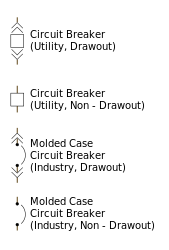Circuit breaker
| Electronic symbol | |
|---|---|
 |
A circuit breaker is an automatically operated electrical switch designed to protect an electrical circuit from damage caused by excess current, typically resulting from an overload or short circuit. Its basic function is to interrupt current flow after a fault is detected. Unlike a fuse, which operates once and then must be replaced, a circuit breaker can be reset (either manually or automatically) to resume normal operation. Circuit breakers are made in varying sizes, from small devices that protect low-current circuits or individual household appliance, up to large switchgear designed to protect high voltage circuits feeding an entire city. The generic function of a circuit breaker, RCD or a fuse, as an automatic means of removing power from a faulty system is often abbreviated to ADS (Automatic Disconnection of Supply).
An early form of circuit breaker was described by Thomas Edison in an 1879 patent application, although his commercial power distribution system used fuses. Its purpose was to protect lighting circuit wiring from accidental short circuits and overloads. A modern miniature circuit breaker similar to the ones now in use was patented by Brown, Boveri & Cie in 1924. Hugo Stotz, an engineer who had sold his company to BBC, was credited as the inventor on DRP (Deutsches Reichspatent) 458392. Stotz's invention was the forerunner of the modern thermal-magnetic breaker commonly used in household load centers to this day. Interconnection of multiple generator sources into an electrical grid required development of circuit breakers with increasing voltage ratings and increased ability to safely interrupt the increasing short circuit currents produced by networks. Simple air-break manual switches produced hazardous arcs when interrupting high voltages; these gave way to oil-enclosed contacts, and various forms using directed flow of pressurized air, or of pressurized oil, to cool and interrupt the arc. By 1935, the specially constructed circuit breakers used at the Boulder Dam project use eight series breaks and pressurized oil flow to interrupt faults of up to 2,500 MVA, in three cycles of the AC power frequency.
...
Wikipedia
